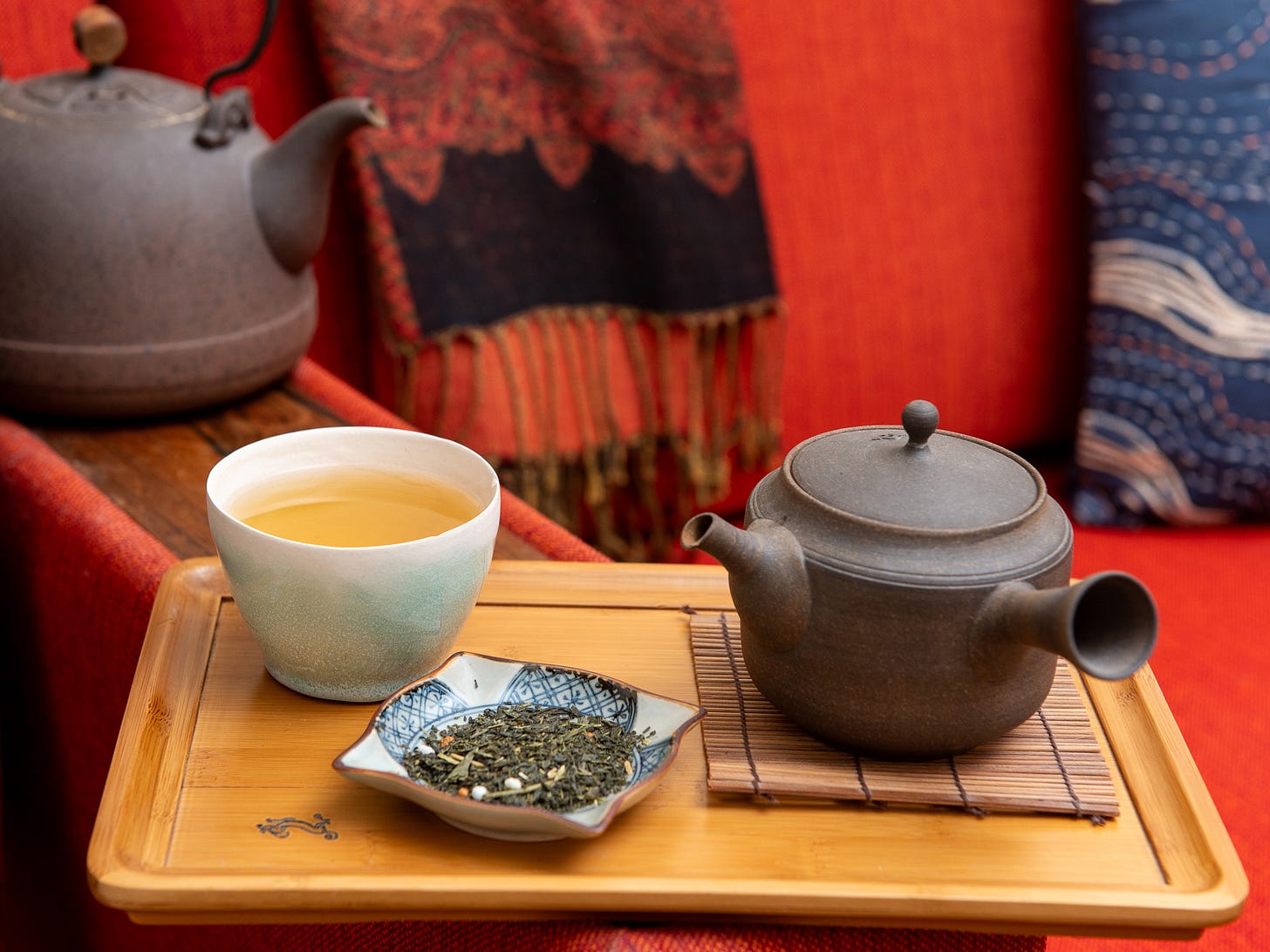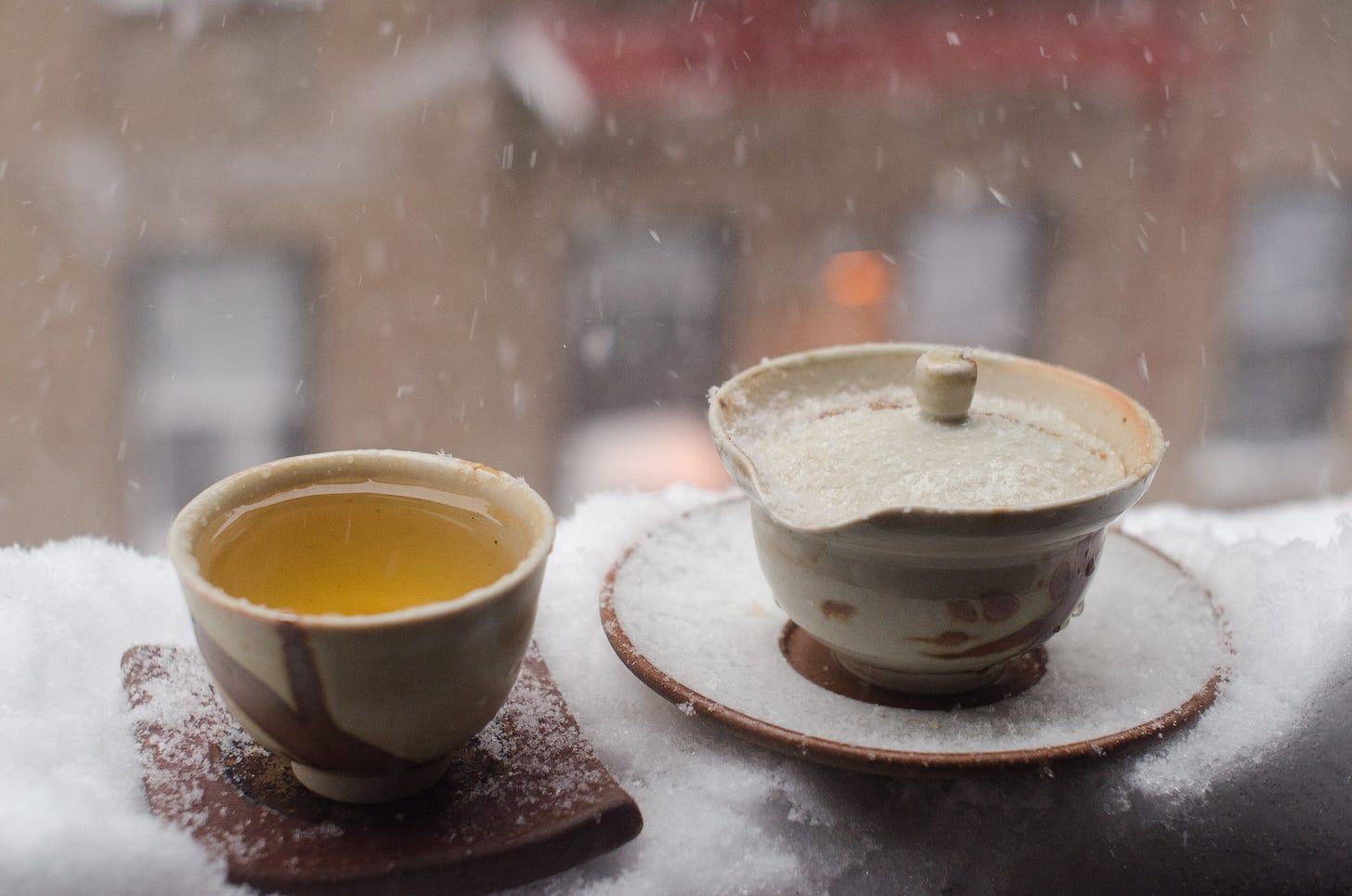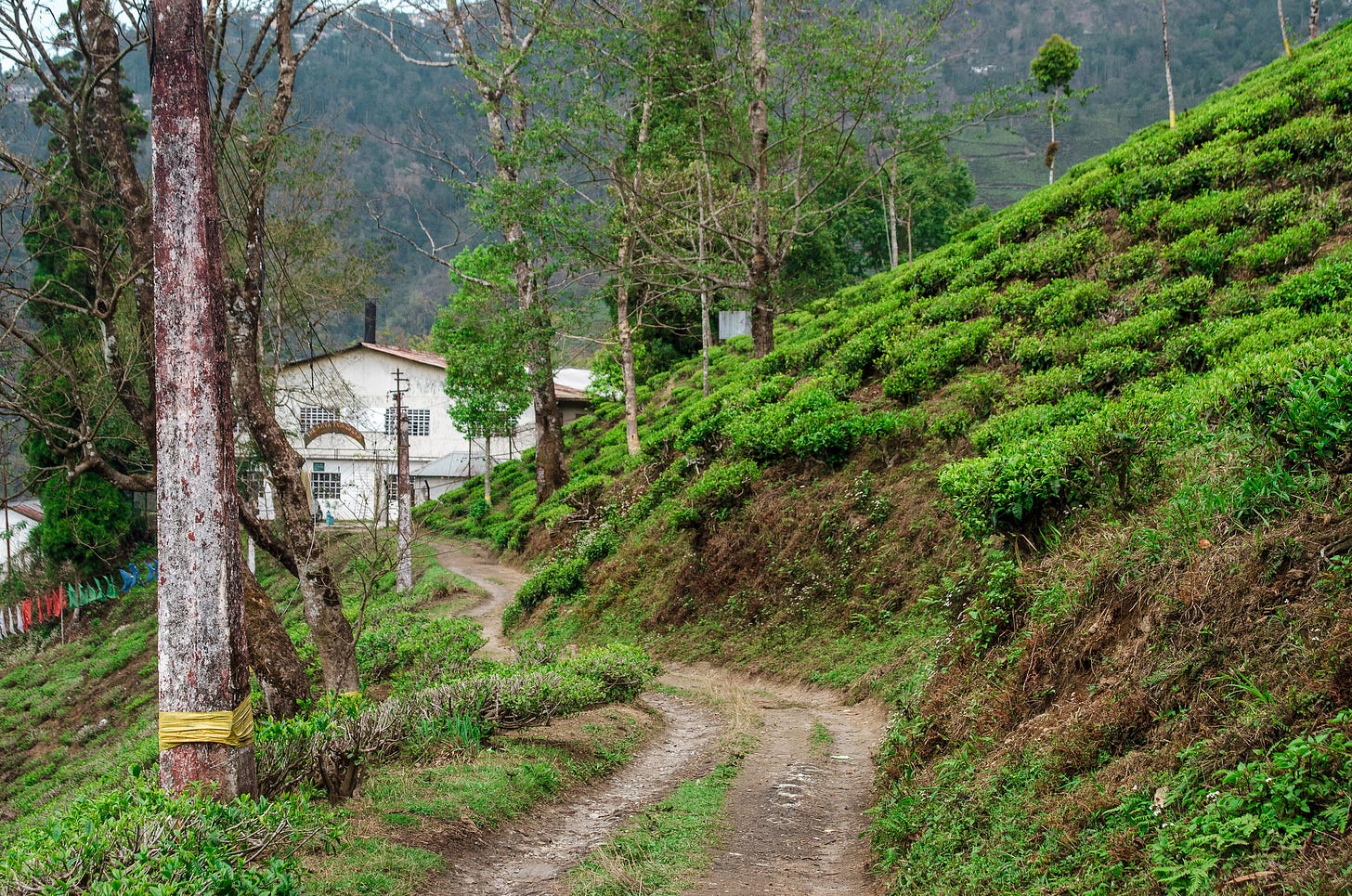Introducing Leafhopper, an insider's guide to the tea world
A newsletter for tea drinkers and allies.
Few crops are as consequential as tea, which has grown into a hundred billion dollar global industry and, one way or another, touched the lips of almost every person on the planet. In more than a decade of journalism, I’ve traveled the world in search of tea’s secrets, meeting with growers, traders, and sellers that rarely speak to the public. I’m starting Leafhopper to help you brew tea better and get more out of your cup, whether you take yours in a bag, an oat milk matcha latte, or an elaborate gong fu service.
Weekly Leafhopper emails have two parts: a free, publicly available digest and a paywalled deep dive exclusive to paid subscribers.
Why you should subscribe
The digest will look much like the one below. Each week, we'll explore a special facet of the tea world: the craft, culture, business, history, philosophy, technology, and chemistry that permeate every cup. I’ll feature a recommended tea with notes about where it comes from and tips to brew a good pot. You’ll get a tour of the world’s tea styles and regions, and an experienced take on what’s worth your attention and dollars.
The deep dive may take the form of an essay, drinking guide, conversation, or travel diary from my research trips to tea gardens throughout Asia. Consider these paywalled stories a candid course in tea appreciation, written to help you become a smarter drinker. Paid subscribers will learn what distinguishes a good tea from bad or merely drinkable, the language of tea and what it means, the art and science of brewing, and how to navigate the tea market as an informed consumer. The way most Westerners talk about tea now is akin to how Americans discussed wine in the 1970s. The best way to improve that understanding is to get a sense of tea beyond the cup to its role as an industry, a cultural institution, and an agricultural product.
Your paid support gives a home to independent, bullshit-free tea writing that’s too niche or weird for mainstream publishers, and hard to find elsewhere on the internet. Believe me, I’ve looked, and I wound up having to write some of it myself.
As a grand opening offer, this week’s deep dive is unpaywalled. You can subscribe for full access to weekly issues for $5 a month or $50 a year. If you can't afford the cost of a subscription but have a passion for tea and desire to learn more, email me and we can make it happen. Readers can donate a subscription or give someone special a gift subscription.
About Max Falkowitz
I'm a food and drink writer who's covered the tea world for the New York Times, Saveur, Imbibe, Bon Appetit, Serious Eats, and other outlets. My tea writing has won awards from the James Beard Foundation and the International Association of Culinary Professionals. I also consult with food and beverage companies about tea marketing, product design, and education. Since 2017 I've worked with the specialty importer In Pursuit of Tea on content marketing and user experience. Elsewhere on the internet, I write a newsletter about bonsai.
And what’s a leafhopper?
Leafhoppers are tiny winged insects that feed on sap from tea leaves. Their bites trigger an immune response within the plant that contributes a honeyed aroma to the finished tea. Some farmers encourage leafhoppers to visit their tea fields, in order to make traditional styles of tea that require the insect bite.
Questions? Requests? Reach me at max.falkowitz@gmail.com; I’d love to hear from you. Now with all that preamble out of the way, let’s get started!
Good fortune tea for the new year
The tea: Obukucha, sold by Ippodo. $10 for 100g.
Kyoto is a wellspring of Japanese tea culture, and obukucha is one of its charming regional traditions. Translated as “good fortune tea,” it’s a tonic drunk during the new year for luck and health. While green tea steeps, the brewer places a preserved sour plum and a knot of dried kelp in a cup, then fills it with brewed tea and, if they’re feeling sassy, tops it with bits of gold leaf. The result is a fragrant and faintly brackish brew that may be just the thing after a night of partying.
Ippodo’s obukucha is just the tea component—BYO plum, kelp, and gold—but its cherry blossom aroma and marine freshness evoke those fortifications nicely. The tea itself is a variation on genmaicha, the workaday blend of lower grade leaves and roasted rice. This batch is made with yanagi bancha, a higher grade than Ippodo’s genmaicha standard, and less rice so the leaf can take the lead. It’s light and refreshing, an herbaceous broth. The new year looks better already.
The source: Ippodo is a 300-year-old tea brand with stores in Kyoto, Tokyo, and New York (currently under renovation). I did some consulting work for the company a few years ago and was continually impressed with the care and precision they put into their marketing materials. Brand integrity matters to them, and their website is one of the more accessible sources of a broad range of traditional Japanese teas.
To brew: Japanese teas can be tricky to brew, and often need to be dialed in batch by batch. That’s one reason I enjoy a lower leaf grade like this obukucha—it’s much more forgiving than a sencha or gyokuro. Still, I recommend a gram scale for precise dosage, as the tightly rolled leaves may be difficult to eyeball. I’m using 5 grams in a 150 milliliter pot (1g/30ml) for 60 seconds, measured from the moment water hits the leaves to the last drop of tea falling into my cup. Re-steep the leaves at least once; the second steeping yields a sweeter, nuttier flavor and a cooling finish.
This is where the free part of the issue will usually end, but here’s a public preview of the deep dives that will be exclusive to paid subscribers in the future. If you like what you see so far, subscribe here, and maybe share this post with your tea friends to support a fledgling project.
When a tea hobby becomes a mental health practice
As with many drugs, I first learned about tea in college from a friend who was in deep. His tea nook resembled an apothecary’s shelf, with mismatched containers of mysterious leaves and artfully designed clay pots. He’d ritualistically warm his teawares with hot water before carefully serving me a shot glass portion of tea in a yunomi, a Japanese cup made for such a purpose. The flavors and subtleties usually went over my head, but the experience felt good, and on an instinctual level, so did the tea. It’s a kindness to make tea for someone. There’s another kindness in allowing yourself to embrace the tea fully, to see where it takes you. Tea is very much a drug, but it makes you work to meet it halfway.
I spent the next several years drinking all the teas I could find. Homemade chai with hand-scraped palm sugar, high mountain Taiwanese oolong—whatever contributed to my mental library of tastes and aromas. I encountered styles that evoked forest floors and peaty whisky. I drank lots of bad tea with glee because I didn’t know any better. Do you remember when you were young and you found your first thing? Maybe it was Legos or lip gloss or Star Wars. Drinking tea fed something in me. It made me feel young; I knew nothing and wanted more. Meeting other tea people in the wild became a secret handshake experience, as if we were members of the same club.
There was a tea shop in Flushing, Queens called Fang Gourmet that I learned about on the Chowhound forums. It was tucked in the back of a little mall under halogen lights past vendors that sold cellphone cases. One day I stumbled in, and unbeknownst to me, the next phase of my tea education began. Fang Gourmet is a Taiwanese style shop where you can pay a small fee to taste five rounds of one of their teas, brewed by their staff. One employee, named Theresa Wong, usually handled the few customers like me who didn’t speak Chinese. Over a series of visits, she became my next tea teacher. You should check out the shop and online store she currently owns and runs, called T Shop.
Theresa taught me the main styles of tea and where they came from. She demonstrated the brewing method colloquially called gong fu cha—literally “tea made with skill”—where the brewer uses small pots and cups, a high concentration of leaves, and repeated steepings to turn a portion of tea into chapters of an unfolding narrative. Each steep is a little different, and because you’re sipping tiny concentrated amounts, you get more of the good stuff with a finer degree of control over the brew. Gong fu brewing is often called a tea ceremony, like the orchestrated matcha ceremonies of Japan. Responsible practitioners insist this is not the case. You can make the process into a ritual if you want, but the point is simply to drink better tea in a way that highlights the experience of the drink over quenching thirst.
What’s the difference between a hobby and a practice? I’m going to make a broad, clumsy distinction that a hobby is something you do for leisure, while a practice, whether for work or recreation, is about cultivating yourself as much as the subject of your interest. I collect vintage marbles and watch horror movies as hobbies, but I don’t think either activity is making me a better person. Practices like writing and bonsai force me to develop skills that change the way I look at and interact with the world and myself.
Somewhere along the way, my interest in tea changed from a fun hobby to a more dedicated practice. I started drinking it daily. I focused my attention on making tea with skill and understanding why it works the way it does. There’s so much to learn about tea: its regional styles, the ways it’s processed, methods of farming, historical developments, the particulars of roasting and aging, the artistic wares, its biochemistry. Tea became a prism through which I could better understand the world.
Around this time is also when my mental health became more problematic. I’ve had depression and anxiety for most of my life, and by my early 20s, it was unignorable. On bad days I barely had the energy to get out of bed, or I was so worked up that I’d snap at anyone close by and spend hours in a spiral of psychological self-flagellation. I was in denial that anything was wrong, and wondered why other people didn’t seem to feel crazy all the time. It wasn’t until years later, when I was 27, that I got into therapy and on some marvelous medications that made daily life less dire. Let me be clear: there’s no substitute for real mental healthcare, and it should be freely accessible to everyone. My burgeoning tea practice wasn’t treatment.
But tea did make life more bearable. Study and brewing practice became beacons of focus in a haze of misery. Despite my despondent periods, I could do something that felt good and seemed to do good for me. If you’ve experienced depression, you may know how revelatory it can be to simply have something to do when you don’t think you can do anything. Drinking tea—exploring tea, thinking about tea—was a reason to get out of bed and face the day. Now, at a much healthier 35, my tea practice offers me ways to navigate the world with greater care and sensitivity. It’s impacted the work that I do, the way I treat relationships, and my understanding of myself. I still know nothing, but I have a better sense of what I don’t know.
There’s a concept in Chinese tea culture that the most interesting sensations of a tea occur from the neck down. Flavor and aroma are fleeting; what’s really special is how a tea interacts with your body and makes you feel. Some quality teas are said to have qi—”breath” or “energy flow”—that can fill you with warmth or a sense of well being. Scientists point to the stimulating effects of caffeine and the amino acid l-theanine, which has been shown in some studies to relieve stress under controlled conditions. All of these effects are hotly debated and difficult to quantify. Anyone who tells you that a given tea has this or that “benefit” is trying to sell you something. And it’s worth mentioning that the placebo effect applies to tea as much as it does to fine wine and diet pills. As with any practice, ironclad principles are impediments to greater understanding.
This is what I mean when I say that tea makes you meet it halfway. For billions of people, tea is a tasty drink that’s part of daily life. That’s all it has to be. But there’s also opportunity to go deeper. Ways to make it rewarding and meaningful beyond a passing pleasure. I believe this is one of the reasons that tea has endured as a cultural fixture for hundreds of years. Tea is indeed a drug, by which I mean it’s a tool to expand your awareness. If you choose to take the journey.










Beautifully written as always - I’m a big believer in making your own rituals and finding ways to slow down while the chaos churns around you. Looking forward to reading more!
Max, so glad you're back in the tea writing game with your own publication on Substack. Thrilled to read more of your writing.
I, too, love the Ippodo Obukucha. Main reason being, it's a genmaicha blended with sencha rather than typical bancha. I'm not a genmaicha lover myself, but the upgrade to leaf quality makes this one worth drinking.